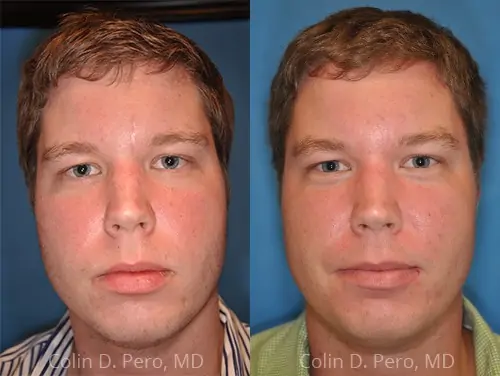Scar revision involves procedures to improve or reduce the appearance of scars caused by an injury, wound, poor healing, or previous surgery. Scar revision attempts to minimize a scar so that it is less conspicuous and blends in with the surrounding skin tone and texture.
A scar is a visible sign that remains after a wound has healed. After an injury from trauma, previous surgery or accidents, scar tissue forms as skin heals. The amount of scarring usually depends on size, depth, and location of the wound; your age; and skin characteristics, such as color (pigmentation).
A scar can be raised or depressed and may differ in color or texture from the surrounding healthy tissue. It is often noticeable due to its size, shape or location, and its unsightly or disfiguring appearance due to poor healing.
There are several different types of scars including:
Atrophic scars are indented scars that heal below the normal layer of skin tissue. They form when the skin is unable to regenerate tissue, and as a result, they leave behind imbalanced scarrings, such as the case with severe acne or chickenpox.
Characteristics: Indented, depressed scars
Hypertrophic scars are thick clusters of scar tissue that develop directly at a wound site.
Characteristics: Raised, red, uncomfortable, may widen over time, darker in color (hyperpigmented) or lighter in color (hypopigmented).
Keloid scars are larger than hypertrophic scars and extend beyond the edges of an original wound or incision. They mostly appear on the face, neck, ears, chest or shoulders where there is little underlying fatty tissue.
Characteristics: Painful or itchy, larger than the original injury
Contracture scars restrict movement due to the skin and underlying tissue that pull together during healing.
Characteristics: These scars can form where this is a large amount of tissue loss, such as after a burn or where a wound crosses a joint, restricting movement of the fingers, elbows, knees or neck.
Stretch Marks (striae) are a type of scarring that form during the rapid growth of the body, such as during puberty or pregnancy. Stretch marks also appear if you lose or gain weight too quickly (obesity).
Characteristics: Indented, reddened
There are several treatment options available to minimize the appearance of scars. Your doctor will recommend the best treatment option for you based on the type and degree of scarring you may have. Some of those options include:
Topical Treatments. These are used to treat existing surface scars and discoloration, and to aid in the healing of scar revision procedures. They can also be used for wound closure and healing. Topical treatments may include gels, tapes, or external compression.
Steroid Injections. Raised and red scars may respond to steroid injections. The steroidal-based compound used reduces collagen formation and can alter the appearance, size, and texture of raised scar tissue.
Injectable Fillers. These can be used to fill depressed or concave scars. Results usually last from 3 months to several years--it all depends on the filler used and the condition of the scar. Therapy must be repeated to maintain results.
Surface Treatments. These treatments are often used for cosmetic improvement of scars to soften surface irregularities and reduce uneven pigmentation. As the name implies, surface treatments are a controlled means of either mechanically removing the top layers of skin or changing the nature of tissue. These treatment options include:
Dermabrasion. Dermabrasion is a procedure that uses a wire brush or a diamond wheel with rough edges to remove and level the upper layer of skin. Once the treated area heals, new skin grows in its place. Surface layers of the skin are removed in order to allow for new skin to grow in from the edges from the wound. This allows for previously uninjured skin to grow along with that of the scar, creating a blended appearance that is more difficult for the eye to perceive.
Laser Scar Revision. Laser scar revision is best performed for raised, reddened or dark scars. It is similar to dermabrasion with regards to indications and results. It is not as successful for longer scars or those on conspicuous areas of the face. In addition, it is not indicated on patients with darker complexions as it may lead to the excessive lightening of the scar which may be more noticeable in the long-term.
Chemical Peels. A chemical peel is a facial skin resurfacing treatment done to improve the skin’s appearance. Mild chemical agents are applied to the skin, which makes it blister and promotes eventual peeling of the superficial layers of skin. The basic principle of skin resurfacing is to promote the new generation and reorganization of the superficial layers of the skin, thereby improving the color, texture, and smoothness of the skin. This is done by removal or intentional injury of the most superficial layers of the skin, which stimulates the growth of new layers of skin. The new skin is usually smoother and less wrinkled than the old skin.
Surgical Treatments. For deeper scars, an incision is needed to surgically remove the old scar.
Re-Excision and Reorientation. Naturally occurring creases and wrinkles in the face (e.g. horizontal wrinkles in the forehead) form excellent areas to reorient scars into for camouflage. Careful excision and re-approximation of the skin edges can create a favorable healing environment for long-term minimal scar formation. Breaking up the scar from a long, straight line can help with camouflage as well, as the human eye tends to notice straight-line scars longer than 3mm. This is sometimes counterintuitive but results in significant improvement from the previous unsightly scar.
Often, scar revision is a staged procedure, with excision and reorientation preceding dermabrasion which is performed 3-4 months later.
There really isn’t a “best time” to have scar revision surgery, as it depends on the age of the scar and wound healing. Ideally, though, you may want to have revision surgery 60 to 90 days after the scar matures.
Scar revision treatment can be performed on people of all ages, especially those who
- Are bothered by the appearance of the scar on their body
- Are physically healthy
- Do not smoke
- Have a positive outlook and realistic goals
- Do not have active acne or other skin diseases in the area to be treated
As with any surgery or treatment, there are risks involved. For scar revision, the risks include:
- Bleeding
- Infection
- Delayed healing
- Anesthesia risks
- Change in skin sensation
- Damage to deeper structures including nerves, blood vessels and muscles, which may be temporary or permanent
- Allergies to tape, suture materials and glues, blood products, topical preparations or injected agents
- Skin discoloration and swelling
- Skin sensitivity
- Skin contour irregularities
- Pain, which may persist
- The potential need for additional surgical procedures or staged procedures
During your consultation, Dr. Pero will ask you various questions about your
- Medical conditions, drug allergies, and medical treatments
- Use of current medications, vitamins, herbal supplements, alcohol, tobacco, and drugs
- Previous surgeries
- Pre-existing health conditions or risk factors
In discussing scar revision surgery, he’ll ask you about your motivation for the surgery, your expectations, and desired outcome. He’ll follow that up with
- Conducting a complete physical exam
- Examining your scar in detail
- Taking photographs of the affected area
- Discussing your options and recommending a course of treatment
- Discussing likely outcomes and any risk or potential complications
At this time, you should ask any questions you may have including those about recovery time, and if anesthesia will be used for your particular treatment. Make sure you have a clear understanding of everything that is involved with your proposed treatment plan before you sign a consent form.
Scar revision can be performed in the operating room at one of our accredited hospitals or surgery center or, alternatively, at our North Texas office location, which is equipped with state-of-the-art technology designed to mitigate the risk of complications and maximize the likelihood of successful treatment outcomes.
In preparing for scar revision treatment, you may be asked to
- Get lab testing
- Take certain medications or adjust your current medications
- Stop smoking well in advance of surgery
- Avoid taking aspirin and certain anti-inflammatory drugs and herbal supplements as they can increase bleeding
After scar revision surgery, bandages or dressing may be applied to keep the surgical site clean. You can also expect localized swelling, discoloration or discomfort, which may take 1-2 weeks to subside. Thereafter, healing will continue for several weeks, and as the new scar heals it will slowly refine and fade.
For chemical peels, dermabrasion, and laser resurfacing, you will experience similar conditions at the treated area, as well as overall sensitivity.
When your treatment is finished, you will be given aftercare instructions that will tell you how to care for yourself following treatment, medications to apply or take orally to aid healing and reduce the risk of infection, and when to follow up with Dr. Pero.
Scar revision surgery results are usually long-lasting; however, it may take a while for your final results to become apparent, as it takes time for the new scar to heal fully and fade.
For some patients, it may take more than one surgical procedure to achieve optimal results.
Dr. Pero is a double board certified facial plastic and reconstructive surgeon, who has performed hundreds of cosmetic procedures.
Click here to view our photos of some of our patients “before and after” photos.
Dr. Pero is a surgeon you can trust:
- He is trained and experienced in all facial plastic surgery procedures;
- He operates only in accredited medical facilities;
- He adheres to a strict code of ethics; and
- He is board certified by The American Board of Facial Plastic and Reconstructive Surgery (ABFPRS) and The American Board of Otolaryngology/Head & Neck Surgery (ABOto).
Click here to request your consultation with Dr. Pero.






